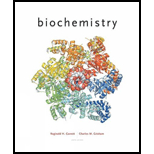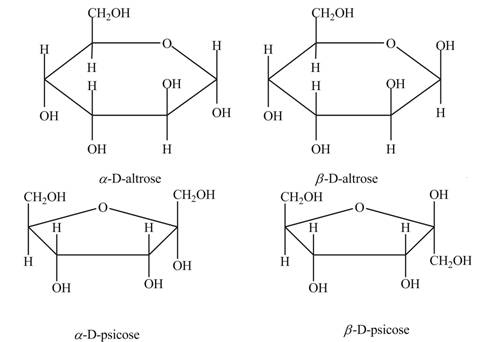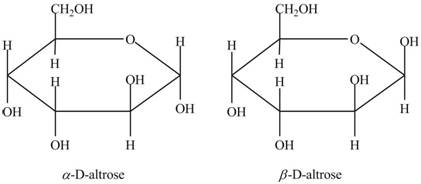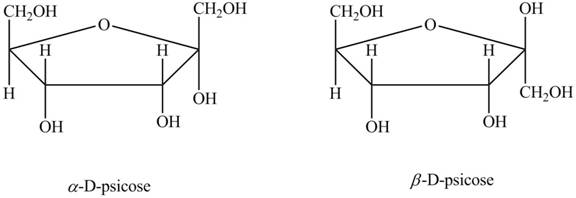
Concept explainers
Answers to all problems are at the end of this book. Detailed solutions are available in the Student Solutions Manual, Study Guide, and Problems Book.
Drawing Haworth Structures of Sugars Draw Haworth structures for the two possible isomers of D-altrose (Figure 7.2) and D-psicose (Figure 7.3).
Interpretation: The Haworth structures for two possible isomers of D−altrose and D−psicose are to be drawn.
Concept introduction: The simplest hydrolyzed form that is obtained from the carbohydrates is known as a monosaccharide.
Haworth projection is a method that is used to provide the three-dimensional cyclic form of a monosaccharide. This method shows the monosaccharide in the form of a hemiacetal ring or hemiketal ring.
Carbon atom which behaves as a stereocenter or a chiral center in the cyclic ring form of the hemiacetal or hemiketal compound is known as anomeric carbon.
Answer to Problem 1P
The Haworth structures for two possible isomers of D−altrose and D−psicose are shown below.

Explanation of Solution
The anomeric carbon of a monosaccharide unit always possesses two types of isomers. One is α− isomer in which the hydroxyl (−OH) group is located below the plane of the ring and the second is β− isomer in which the hydroxyl (−OH) group is located above the plane of the ring.
The molecular formula of D−altrose is C6H12O6 . The two possible isomers of D−altrose are α−D−altrose and β−D−altrose . The Haworth structures for two possible isomers of D−altrose are shown below.

Figure 1
In the Haworth projection of α−D−altrose , the hydroxyl (−OH) group which is present at the anomeric carbon is located below the plane of the cyclic ring. On the other hand, in β−D−altrose , the hydroxyl (−OH) group which is present at the anomeric carbon located above the plane of the cyclic ring.
The molecular formula of D−psicose is C6H12O6 . The two possible isomers of D−psicose are α−D−psicose and β−D−psicose . The Haworth structures for two possible isomers of D−psicose are shown below.

Figure 2
In the Haworth projection of α−D−psicose , the hydroxyl (−OH) group which is present at the anomeric carbon is located below the plane of the cyclic ring. On the other hand, in β−D−psicose , the hydroxyl (−OH) group which is present at the anomeric carbon is located above the plane of the cyclic ring.
Want to see more full solutions like this?
Chapter 7 Solutions
Biochemistry
- You’ve isolated a protein and determined that the Native molecular weight of the holoenzyme is 160 kD using size exclusion chromatography. Analysis of this protein using SDS-PAGE revealed 2 bands, one at 100 kD and one at 30 kD. The enzyme was found to be 0.829% NAD (by weight). What further can be said regarding the structure of the polypeptide?arrow_forwardWhat is the formation of glycosylated hemoglobin (the basis for the HbA1c test)? Can you describe it?arrow_forwardPlease analze the gel electrophoresis column of the VRK1 kinase (MW: 39.71 kDa). Also use a ruler to measure the length of the column in centimeters and calculate the MW of each band observed. Lane 1: buffer Lane 2 : Ladder Lane 3: Lysate Lane 4: Flowthrough Lane 5: Wash Lanes 6-8: E1, E2, E3 Lane 9: Dialyzed VRK1 Lane 10: LDHarrow_forward
- Do sensory neurons express ACE2 or only neurolipin-1 receptors for COVID19 virus particle binding?arrow_forwardExplain the process of CNS infiltration of COVID19 through sensory neurons from beginning to end, including processes like endocytosis, the different receptors/proteins that are involved, how they are transported and released, etc.,arrow_forwardH2C CH2 HC-COOO CH2 ܘHO-C-13c-O isocitrate C-S-COA H213c CH2 C-OO 13C-S-COA CH2 C-00 the label will not be present in succinyl CoA C-S-COA succinyl-CoAarrow_forward
- A culture of kidneys cells contains all intermediates of the citric acid cycle. It is treated with an irreversible inhibitor of malate dehydrogenase, and then infused withglucose. Fill in the following list to account for the number of energy molecules that are formed from that one molecule of glucose in this situation. (NTP = nucleotidetriphosphate, e.g., ATP or GTP)Net number of NTP:Net number of NADH:Net number of FADH2:arrow_forward16. Which one of the compounds below is the final product of the reaction sequence shown here? OH A B NaOH Zn/Hg aldol condensation heat aq. HCI acetone C 0 D Earrow_forward2. Which one of the following alkenes undergoes the least exothermic hydrogenation upon treatment with H₂/Pd? A B C D Earrow_forward
- 6. What is the IUPAC name of the following compound? A) (Z)-3,5,6-trimethyl-3,5-heptadiene B) (E)-2,3,5-trimethyl-1,4-heptadiene C) (E)-5-ethyl-2,3-dimethyl-1,5-hexadiene D) (Z)-5-ethyl-2,3-dimethyl-1,5-hexadiene E) (Z)-2,3,5-trimethyl-1,4-heptadienearrow_forwardConsider the reaction shown. CH2OH Ex. CH2 -OH CH2- Dihydroxyacetone phosphate glyceraldehyde 3-phosphate The standard free-energy change (AG) for this reaction is 7.53 kJ mol-¹. Calculate the free-energy change (AG) for this reaction at 298 K when [dihydroxyacetone phosphate] = 0.100 M and [glyceraldehyde 3-phosphate] = 0.00300 M. AG= kJ mol-1arrow_forwardIf the pH of gastric juice is 1.6, what is the amount of energy (AG) required for the transport of hydrogen ions from a cell (internal pH of 7.4) into the stomach lumen? Assume that the membrane potential across this membrane is -70.0 mV and the temperature is 37 °C. AG= kJ mol-1arrow_forward
 BiochemistryBiochemistryISBN:9781305577206Author:Reginald H. Garrett, Charles M. GrishamPublisher:Cengage Learning
BiochemistryBiochemistryISBN:9781305577206Author:Reginald H. Garrett, Charles M. GrishamPublisher:Cengage Learning
